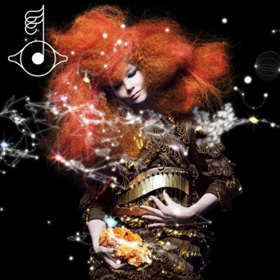Biophilia by Bjork

4/5
Most people associate Bjork with a horrific swan gown worn at 2001’s Academy Awards—but as it goes she happens to have achieved much more than just fashion infamy. It has been four solid years since Bjork released her seventh full-length album Volta (2007), and we are relieved to discover (even after a pushed back release date) that her long awaited album Biophilia has finally found us. Biophilia is a ground breaking album that investigates different ways of experiencing music through science and nature. Leave it to Bjork, a full time music-pioneer, to collaborate with Apple in creating the very first “app album.” And it is strange.
I first encountered Bjork’s peculiar voice when watching the art house film, “Dancer in the Dark” (2000), where she plays an immigrant factory worker named Selma. The scene that captured me the most featured a duet with Radiohead’s Thom Yorke titled “I’ve seen it all” (later nominated and performed at the 2001 Oscars). It’s by far one of the strongest tracks that I have ever heard before. This is a very notable trait of Bjork’s—she is forever able to capture her audience’s attention with the sheer oddity of her voice, which is extraordinary.
Much like a proficient visual artist, I find Bjork’s music to be much more conceptual than anything else. Lyrically, she is not masterful on Biophilia, but who is paying attention to the lyrics anyways? The electronic beats bombard the listener like a million wind chimes colliding, but in unexpected ways it forms ghostly, organized chaos. “Crystalline” is the most developed track on Biophilia, and it was previously released as a single on June 28th, 2011 serving as a preamble to the album. “Crystalline” was created predominately through a tablet computer, and the production combines a range of musical instruments that were created specifically for this album—such as the Tesla Coil used in “Thunderbolt” and her groupings of pendulums that convey arrangements of the earth via the reverberation of a harp. “Cosmogony,” “Virus” and “Moon” are previous digital releases—all of which have an eerie celestial sound confirming Bjork’s unwavering interest in both DNA and the orbit of planets. The album ends with a commanding sonic track titled “Nattura,” which is packed with repeating drum beats and vaporous voices that make listeners wonder if perhaps aliens are indeed nearby.
Biophilia is a beautiful compilation of what listeners have always understood about Bjork, but this time it’s almost entirely about the experimentation of her music. The album seems to flow into one giant conglomerate of a song—I’m not sure if this is a good or a bad thing. I’m also not convinced that the “app” really strengthens her work, but I do know for certain that it’s ingenious. Much like Bjork herself, Biophilia is entirely haunting, inventive and avant-garde.
RELATED ARTICLES
Get the most-revealing celebrity conversations with the uInterview podcast!





Leave a comment